How many times have you seen a horse finish strongly to win, only to plod home as an unplaced favourite at its next run? What about the front-runner that defies all challengers in the straight one start, but is then beaten on the turn at its next?
These sudden form reversals may seem like just another element in the great uncertainty of racing, but more often than not they can be explained by one very important factor: the influence of early pace.
Early pace refers to the speed each race settles into after the field has accelerated from the barriers and jockeys have found their position in running. What makes early pace so important is that it varies from race to race, depending on the preferred running style of each horse, their barrier draw and the riding tactics of jockeys.
In some races there may only be one preferred leader that is able to take up its position with little effort.
This allows the jockey to create a slow early pace and conserve energy for the sprint home. In other races there may be a number of front-running types and jockeys have to keep their mounts going at a good pace to maintain position. This creates a much more genuine and sometimes fast early pace.
Different levels of early pace will suit some horses more than others. Consider the following example of three races run over 1200m. All races finish with the same final time of 70 seconds, but each has a different level of early pace.
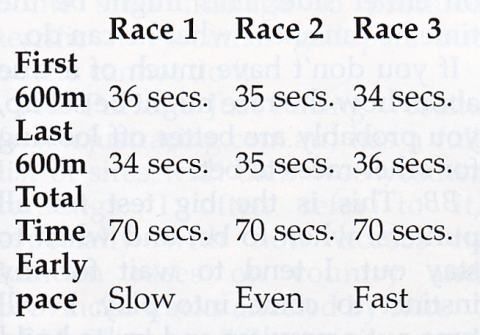
How does the level of early pace affect the winning chances in each race? Let's take a look.
RACE 1 - SLOW EARLY PACE
In this race, the leaders have had an easy time in front and run the first 600m in 36 seconds. With plenty of energy in reserve, they sprint home in 34 seconds to finish the race in 70 seconds.
If the leaders are sprinting home in 34 seconds, the runners behind them need to sprint faster to make up enough ground to win. Diagram 1 shows the task different horses face over the final 600m of this race.
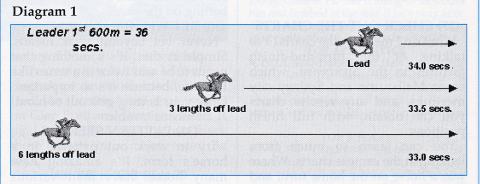
A horse 6 lengths off the lead must sprint its final 600m in 33 seconds, while a horse 3 lengths off the lead requires a final 600m of 33.5 seconds, just to finish in a dead heat with the leaders. Only very good horses are capable of breaking 33.5 seconds over the final 600m of a race and all but a very few top-class horses in Australia could break 33 seconds.
In reality a horse 6 lengths back in this race stands next to no chance of winning, while a horse 3 lengths away has a slight chance, but only if it's well above average in ability. Leaders and those within one length of the lead in this race are ideally suited. Assuming they have an overall time ability that is competitive with the field, one of them is almost certain to win.
RACE 2 - EVEN EARLY PACE
Here the leaders run along at a more even speed of 35 seconds for the first 600m with enough energy to sprint home in the same time of 35 seconds. Horses off the lead are now a little more suited as you can see in Diagram 2 .
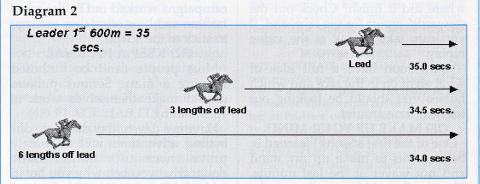
A horse 6 lengths off the lead in this race would need to run its final 600m in 34 seconds to finish equal with the leaders. This is 1 second slower than what was required under slow pace conditions. It still takes a very good performance to win in these conditions, but the task is certainly within reach.
RACE 3 - FAST EARLY PACE
In this race the leaders run along quickly, clocking 34 seconds for the first 600m with only enough energy to run home in 36 seconds. Horses off the lead now face a much easier task see Diagram 3.
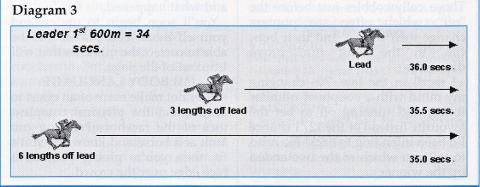
A horse 6 lengths off the lead only needs to run its final 600m in 35 seconds, 2 seconds slower than they have to if the early pace is a leisurely 36 seconds.
Backmarkers in these types of races are suited and are capable of winning.
We can see that even though the final time is the same, the level of early pace has a profound effect on the winning chance of each horse and how each race is likely to finish.
As these examples show, reliable estimation of early pace is the most important piece of information a punter can possess.
Understanding how well each horse is likely to be suited allows you to sort out the winning chances from the no-hopers, with more confidence than you ever thought possible.
The following is an example of the likely speed shape in a race.
| SPEED SHAPE | Slow | Fast |
| | Early | Late |
This shows that the early pace is likely to be slow and the final section is likely to be fast. From the above example you know that horses more than a couple of lengths off the lead in this situation face a very difficult, if not impossible, task to win.
Table 1 will help you decide how well horses with a certain running style are suited in different pace conditions.
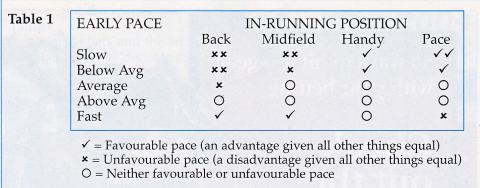
As you can see, it is generally an advantage to be on the pace or handy in running. These types of horses are much more likely to encounter favourable or at least neutral pace conditions. Relative frequency statistics show that pace and handy runners win approximately 1.8 times the number of races they should, while backmarkers only win 0.3 times as often as they are expected to.
Of course, pace suitability needs to be considered in the context of the horse's ability and current form.
- Runners that don't measure up on ability will struggle to win no matter how suitable the pace conditions are.
- Runners competitive in ability need at least neutral, but ideally favourable, pace to win.
- While not ideal betting propositions, runners with ability beyond others can often overcome unsuitable pace and still win.
- The best type of bet is a horse with an edge in ability that will be well suited by the pace, especially if other closely rated runners will be unsuited.
By incorporating the study of pace into your form analysis you will make smart decisions to stay off horses that are unsuited and bet with more confidence on your fancies that are well suited.
You will have the knowledge and confidence to take your punting to a whole new level . . . a level that delivers fewer losers, more winners and a stack of extra money in your pocket!
By Daniel O’Sullivan
PRACTICAL PUNTING – JANUARY 2004